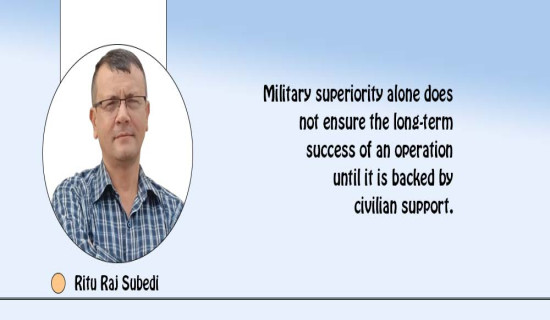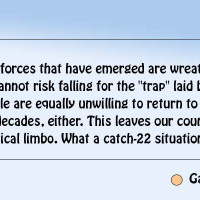- Monday, 12 January 2026
Geography Dictates Nation’s Destiny
Geography and history are twin lenses through which a nation views others and is viewed in return. British historian Dominic Green writes “geography is destiny for nations and history the proof.” Nepal sits in a strategic position between two huge and powerful neighbours: India and China. It is geographically diverse consisting of mountainous region, central hilly areas and the fertile plain Terai. Nepal is a melting pot of multi-ethnic, multi-religious, multicultural, and multilingual groups. Cultural pluralism in a diverse landscape is a unifying thread and providing social stability. Nepal has witnessed harmony and tolerance among these diverse groups for ages. It is blessed with immense natural endowments, and mineral deposits. Nepal lives in scarcity amidst such abundance. Over 6 million Nepali youth are abroad in search of work opportunities.
Nepal’s land mass ranges from 62 metres in the south to 8,848 metres elevations of Sagarmatha (Mount Everest) in the north within a distance of 184 kilometres. Kathmandu is 3,000 kilometres away from Beijing, 900 kilometres away from New Delhi. Nepal is a landlocked and least developed country. Nearest sea access through India is 670 kilometres and seaport through China is 3267 kilometres in Tianjin. Geographical difficulties make access to sea through China exorbitantly expensive. Nepal shares borders (1880 kilometres) with India on the south, east, and west and with China (1415 kilometres) on the north. Nepal is 23 and 68 times smaller than India and China respectively. While border with India is open, Nepal shares border with Tibet- a “core security concern” for China.
Solidarity
Foreign policy is said to be an extension of domestic policy. No nation can be stronger than it is at home. Internal unity and solidarity equals external clout and credibility. American Secretary of State Antony Blinken says, “Our strength at home goes directly to our standing around the world.” A whole of government approach needs to be institutionalised and strengthened for close inter-ministerial coordination, and consolidated diplomatic practice. Partisanship and foreign policy do not go together. Nations develop a unified stance on foreign policy, and speak with one voice on issues of national interests. A strong and efficient foreign service is established to transform challenges into opportunities.
Several actors and factors influence the shaping and making of foreign policy. Prominent among others include geography, history, demography, economic and military strength, culture, natural resources, technology, and environmental issues. Unlike in autocratic system, the base of foreign policy gets widened in democracy where political parties, parliament, media, diaspora, interest and lobbying groups come into play. Situation prevailing at particular times in international settings also influences foreign policy. Above all, the political culture and traits of a nation’s leadership, its determination, clarity and credibility define the overall landscape and world view.
Of these factors, geography is of paramount importance. “To know a nation’s geography was to know its foreign policy,” said Napoleon in 18th century. Geography does not argue, and “is the most fundamental factor in the foreign policy of states because it is the most permanent. Ministers come and go, even dictators die but mountain ranges stand unperturbed,” wrote Nicholas J. Spykman. The economic, political and technological landscapes have undergone significant transformations since then, demanding a comprehensive understanding of emerging challenges in line with the evolving realities of time and shifting power dynamics.
“Economic strength, and technological prowess, superior intelligence have changed the dynamics in foreign policy making,” nevertheless, wrote Zbigniew Brzezinski, “geographic location still tends to determine the immediate priorities of a state- and the greater its military, economic and political power, the greater the radius beyond its immediate neighbours, of that state’s vital geopolitical interests, influence and involvement.”
India and China- both rising and competing global powers, constitute the core of Eurasia, where there is a fierce contest for global primacy as the power shift from Atlantic to the Pacific, based on their growing power, influence and growth. They are the world’s second and fifth largest economies and maintain different social and political systems. With global power politics focused on Nepal’s neighbours, a complex set of interrelated geopolitical challenges at its doorsteps, the conduct of Nepal’s foreign policy has become broader and more complex.
The geopolitical transformations involving the US, China, Russia, India and other powers in between, and two ongoing wars cannot be viewed in isolation. They have heightened the sensitivity and complexity of Nepal’s foreign policy. Nepal’s foreign policy has become globally oriented following the diversification of diplomatic relations with 183 countries, guided by the five principles of peaceful co-existence - Panchsheel. Nepal adheres to the policy of non-alignment that rejects security alliances and avoids alignment with any powers. Nepal sitting next to the world’s largest markets with a combined population of 2.5 constituting about 40 per cent of the world’s population, which is as much as the population of the next 20 largest countries taken together, faces both challenges, and opportunities.
Geopolitical moment
There is a geopolitical moment. Nepal needs to do its homework properly, consider a broader picture, identify vital interests, clearly prioritise them, make an objective assessment of emerging trends of unfolding challenges and project a clear vision to effectively address challenges and seize emerging opportunities. It is only through institutional capacity that generates ingenuity and wisdom. Without thorough and coordinated preparation, clear priorities and a well-defined vision, however tall and promising, remain empty promises. It all comes to the leadership, which involves taking a stand and articulating a clear vision, as Lee Kwan Yew said, “A nation is great not by its size alone. It is the will, the cohesion, the stamina, the discipline of its people and the quality of their leaders which ensure it an honourable place in history.”
Leaders should lead by example through their sincere and hard work and dedication rather than coining slogans to seek momentary attention. Trustworthiness has to be earned, selflessness shown in actions and pragmatism reflected in wisdom. Nepal must embrace pragmatism, and conduct a balanced and independent foreign policy over coining catchy slogans for momentary gain. Its primary challenges remain preserving sovereignty, protecting independence and territorial integrity and accelerating the process of socio-economic transformation within an overall framework of democratic pluralism. A peaceful and prosperous Nepal is essential for the world. A troubled Nepal is not without profound consequences for global peace, security, and prosperity. Altering ground realities is a wishful thinking.
(Bhattarai, Ph. D., is a faculty member of the Institute of Crisis Management Studies (ICMS), Tribhuvan University. dineshbhattarai@tuicms.edu.np)










-(1)-original-thumb.jpg)






